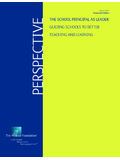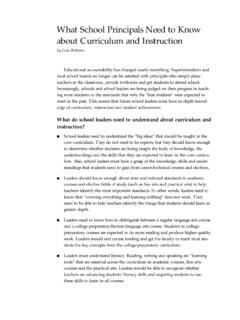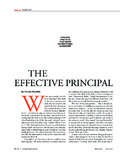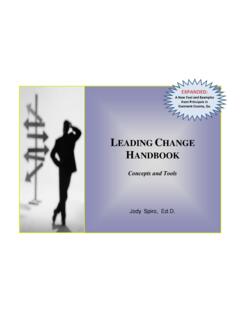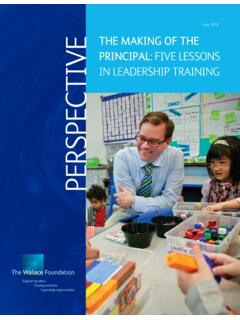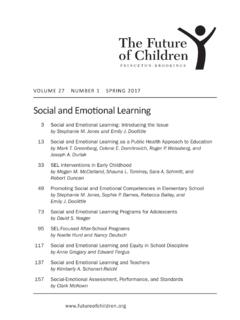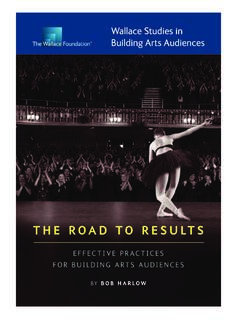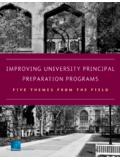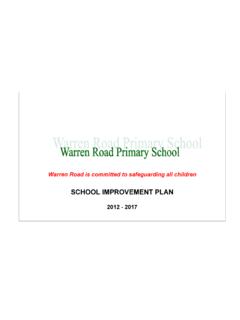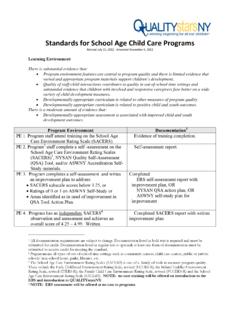Transcription of LEADING CHANGE HANDBOOK - Wallace Foundation
1 LEADING CHANGE HANDBOOK Concepts and Tools Jody Spiro, : A New Tool and Examples from Principals in Gwinnett County, Ga. i Copyright 2009, 2018 by Jody Spi ro. All rights reserved. To download the HANDBOOK , please go to LEADING CHANGE HANDBOOK : Concepts and Tools Table of Contents FOREWORD AND ACKNOWLEDGEMENTS I. INTRODUCTION 1 II. ASSESSING READINESS 3 Tool: Readiness Rubric III. ANALYZING STAKEHOLDERS 7 Tool: Stakeholder Strategizer IV. PLANNING EARLY WINS 14 Tool: Early Win Wonder V. MINIMIZING RESISTANCE 16 Tool: Resistance Reducer VI. USING COLLABORATIVE PLANNING 19 Tool: Collaborative Planning Parameters VII.
2 SPREADING AND SUSTAINING CHANGE 26 Tool: Scale & Sustainability Score Sheet VIII. CONTINUOUS IMPROVEMENT/COURSE CORRECTION 33 Tool: The 3 R s: Review, Revise, Repeat IX. THE LEADING CHANGE HANDBOOK IN ACTION: 34 Stories from the Gwinnett County principals ii iii FOREWORD and ACKNOWLEDGMENTS This HANDBOOK and the tools it contains have been many years in the making. They were born and developed from a sense that there are several useful techniques for LEADING CHANGE that could be translated into tools to assist busy leaders. They reflect, and owe to, a rich body of thinking in this field as well as my own career experiences. This includes work I began as head of professional development for the operations department at Chase Manhattan Bank and continued through stints at the New York City Board of Education, Long Island University, and through my international public sector reform work at the Soros Foundations and Education Development Center.
3 Over the last 20 years, hundreds of my students at NYU s Wagner Graduate School of Public Service have used these tools and materials. During my work at The Wallace Foundation , state and district leaders participating in the Foundation s education leadership initiatives have been using them as they pursue lasting CHANGE in their education systems. The ideas and views expressed in this volume are mine alone. But I wish to acknowledge and thank my colleagues at The Wallace Foundation who helped me in exploring the use of these CHANGE tools with the Foundation s grantees. I am especially grateful to the superb CHANGE leaders of Gwinnett County Public Schools: CEO J. Alvin Wilbanks, Assistant Superintendent for Leadership Development Glenn Pethel and principals Susan Bearse, Jeff Lee, Toni Ferguson, Lamont Mays and their colleagues. The team I work with at Wallace provides important perspective on a daily basis: Deanna Chernovetsky, Aiesha Elesusizov, Lucas Held, Rochelle Herring, Will Miller, Edward Pauly, Nicholas Pelzer, Jessica Schwartz, and Elizabeth Wilde.
4 Gratitude is extended to the dynamic duo who edited this material and made sure that the language was clear, engaging, accurate and well organized Jennifer Gill and Pamela Mendels. Many thanks for your huge contributions. Finally, thanks to Jos Moreno, who is a genius when it comes to creating graphics and contributed his expertise to this SECTION I: INTRODUCTION The subject of LEADING CHANGE is of paramount importance for leaders these days since it seems that the only constant is change1 CHANGE can be a dynamic and positive force for creating new strategies and putting them in action, stimulating creativity, diversity, learning and growth. But CHANGE of the sort this HANDBOOK is about is a deliberate disruption of the status quo. While the need for CHANGE will often be apparent to many or most of those affected, opposition, resistance and unanticipated consequences are all likely to emerge. These must be taken into account in the planning and implementation.
5 Even posit ive CHANGE can be stressful. An effective CHANGE leader can maximize the opportunit ies of CHANGE while minimizing the risks. Unfortunately many CHANGE efforts fail or are less successful than originally conceived. This is not surprising since unforeseen circumstances are likely to arise, participants may feel uncertain and unprepared for what is to come, stakeholders may oppose disruption of their current influence or people may feel disempowered. There can be no guarantee of success up front. LEADING CHANGE therefore requires continuous analysis of the situation and mid- course corrections. It includes the ability to think several steps ahead and then plan the present with the future in mind, put plans quickly into action and continuously monitor and revise the work to take advantage of -or mit igate- unintended consequences as they arise. A missing ingredient for many practitioners has been how to translate concepts into action, continuous improvement and sustainable results.
6 This toolkit has been developed to fill that need in several key areas of the CHANGE process: assessing and improving participants readiness; engaging stakeholders; planning early wins; minimizing resistance; using collaborative planning methods; and developing ways to bring initiatives to scale and sustain them over time. As a leader of CHANGE , you will need not only to develop strategies, but also to project what will happen to various other parts of the system as a result. It is clearly desirable to plan for CHANGE at the beginning of an initiative; however you can enter the CHANGE process at any point as long as you recognize the dynamics of the CHANGE process and have tools to use. The chart on page two presents an overview of the CHANGE process, indicating where a tool in this HANDBOOK corresponds to an action step. Whether one begins at the onset of the planning process or is trying to make mid- course corrections, there are key questions to be addressed: How can we ensure that what is planned will be well implemented and achieves the original intention?
7 What is the best way to start? How can we keep getting better at what we do and build those improvements into subsequent plans? What would scale and sustainability look like? What steps can we build into our planning and implementation to increase the likelihood of sustaining the desired CHANGE and expanding its reach? This HANDBOOK is designed to help you address these key questions throughout the CHANGE process. It includes six tools, a brief description of the underlying concepts of each and suggestions on how to use the tools and the resulting data. The tools are appropriate for any CHANGE circumstance: examining the organization internally, the external environment or even as a self-assessment of what you need to do to carry out each action step. The HANDBOOK may be downloaded by going to You may find it helpful to use the tools online where the text boxes will expand to accommodate your narrative and where the calculations for the Sc al e & Sustainability Score Sheet will be done automatically when you click on the total boxes.
8 1 CHANGE means something different from the current state, a departure from the status quo. CHANGE involves going from one s ituation to another a period of transition. It i s a continuous process. Therefore, CHANGE can best be conside red as series of destinations that lead to further destinations. In this way, a le ader can benchmark goals and i ndicators of success at various intervals and make course corrections as LEADING CHANGE ACTION STEPS Be clear and specific: - What is the desired CHANGE ? - What are the underlying concepts guiding the development of strateg y? - How will you know if you have succeeded? - What are benchmarks along the w ay? Start from where you are Assess and improve the readiness of participants Tool: READINESS RUBRIC Analyze stakeholders Tool: STAKEHOLDER STRATEGIZER Build in an early win Tool: EARLY WIN WONDER Anticipate resistance Tool: RESISTANCE REDUCER Use collaborative planning Tool: COLLABORATIVE PLANNING PARAMETERS Plan for scale and sustainability and implement the plan (Although this is listed near the end, plan for this from the be ginning) Tool: SCALE & SUSTAINABILITY SCORE SHEET Continuous Improvement/course corrections Evaluate for continuous improvement and mid- course corrections Revisit readiness; it should improve and therefore strategies might CHANGE Tool: The 3Rs: REVIEW, REVISE, REPEAT 3 SECTION II: ASSESSING READINESS Main concepts2 As a first step, leaders should assess the readiness of the participants for the CHANGE before designing the intervent ion.
9 "Readiness" refers to the combination of factors evident in participants: their previous experience with such endeavors, the degree to which they have the necessary skills and knowledge for the tasks ahead and their attitude toward undertaking this CHANGE (their enthusiasm and willingness to take responsibility). Groups that are hi gh readiness (meeting the highest standards for all three categories of experience, attitudes and skills) need less structure from the leader. They can be more self-directed as long as there are clear and specific objectives and expected outcomes. Bear in mind that if a group is low readiness in any of these three categories, you should consider them low readiness overall. And most groups undergoing a CHANGE will likely be low readiness since they will likely lack previous experience with the strategy that is changing. Such low readiness groups will need much more structure and guidance until they experience success and have more confidence in the CHANGE process and in themselves as they help carry it out.
10 In practice, you will want to employ different strategies to correspond with the readiness of any given group. For example: Low readiness groups need HIGH STRUCTURE strategies, largely initiated by the leader, such as: Specific, clear outcomes (objectives) with timelines and evaluat ion criteria Templates for work plans and budgets A written meeting agenda including ground-rules for participat ion Written recording of decisions reached at a meeting that are promptly distributed3 Continuous review of progress and mid- course corrections through a defined structure, such as regularly-scheduled meetings Structured questioning to lead group conversation4 Medium-readiness groups need MODERATE STRUCTURE strategies such as: Decision-sheets, perhaps written by each participant on a rotating basis for a series of meetings Jointly-set meeting agendas and ground-rules Collaborative planning5 High-readiness groups need LIGHT STRUCTURE strategies such as: Jointly setting the objectives and letting the group decide how to achieve them.
